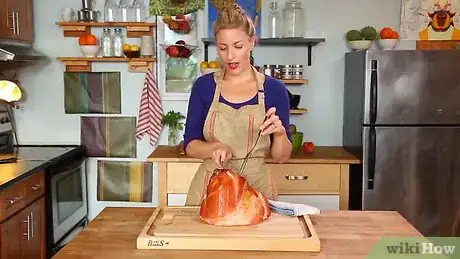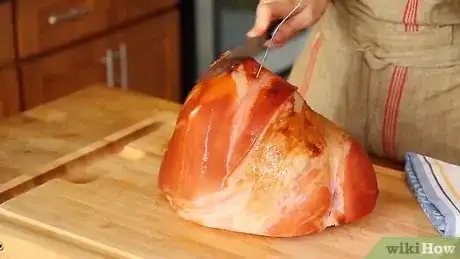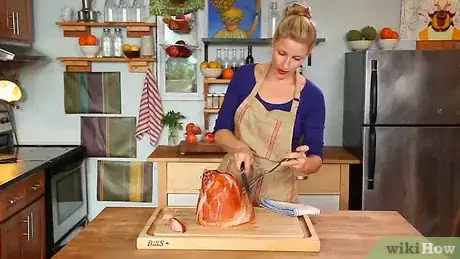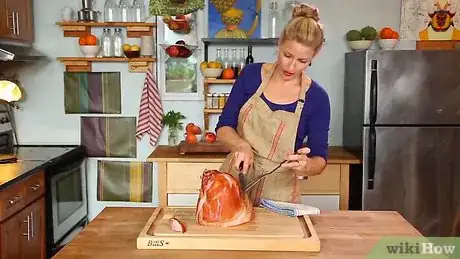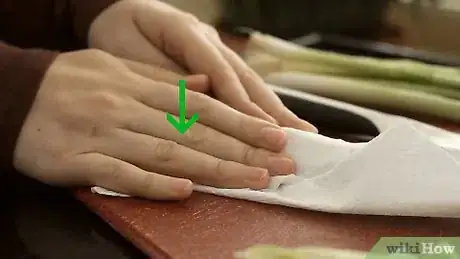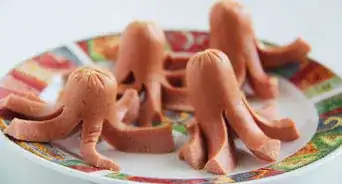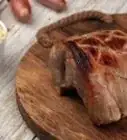This article was co-authored by Ollie George Cigliano. Ollie George Cigliano is a Private Chef, Food Educator, and Owner of Ollie George Cooks, based in Long Beach, California. With over 20 years of experience, she specializes in utilizing fresh, fun ingredients and mixing traditional and innovative cooking techniques. Ollie George holds a BA in Comparative Literature from The University of California, Berkeley, and a Nutrition and Healthy Living Certificate from eCornell University.
This article has been viewed 200,690 times.
Carving a ham may seem difficult to do properly, but it isn't too difficult to learn. If you are planning on serving a ham, you will want to know the right technique to cut perfect juicy slices of ham to serve to your guests. Once you understand the process it's easy enough to remember for the next time you're cooking some delicious ham.
Steps
Carving a Whole Ham
-
1Place your ham on a cutting board. Take a large knife and trim off two or three slices from the thin side of the ham, cutting parallel to its length. Then turn the ham so it rests on the flat surface you just created by trimming off the slices.
- Use a very sharp knife. Having a sharp knife will help you to cut your ham in thin, perfect slices.
- Be sure the knife is long enough to cut through the width of the ham and use long smooth strokes to slice the ham more easily.
-
2Use a large fork to stabilize the ham. Pierce the top of the ham with a large fork and insert the fork as far down into the meat as you can. If you hit the bone right away, try moving the fork slightly up or to either side and insert it again. Once the tines are all the way inside the ham, you should have a nice stable handle to hold while making your cuts.
- The key to carving a ham safely and successfully always starts with the right tools. The best fork to use is a chef's fork. It has two long tines and measures about 11 inches long, with a handle that features a base to rest your forefinger and thumb. Whether you’re left or right-handed, a chef’s fork is a great tool for holding the meat down while you slice with your other hand.
Advertisement -
3Carve the shank end. Hold the ham with a large fork, start slicing at the shank end (which should be more pointed/tapered than the butt end). Cut thin, vertical slices across the ham, sinking the knife all the way down to the bone for maximum effect.[1]
- If possible, use a chef's knife for this. It has a long blade, usually measuring between 8 and 14 inches. It is the perfect tool for easily slicing through ham.
-
4Remove the slices. Once the slices are cut, make a horizontal cut that is parallel to the bone. This will release the slices you've made. Place these slices on a serving platter. Turn the ham and continue carve slices using this method until there is no meat left on the bone.
- Only carve the ham that you need to serve. Leave the remainder on the bone so that it stays warm and retains more of its juiciness.
- Be sure to hang on to the ham bone and any scraps. You can use them to make a delicious soup.[2]
Carving the Shank Half
-
1Place the ham on a cutting board. Take a large knife and trim off two or three slices from the side of the ham, creating a flat surface. Turn the ham so it rests on this flat surface.[3]
-
2Slice at the narrow end of the ham. Stabilize the ham using a large fork. Start cutting quarter-inch slices down the ham. Use long, smooth knife cuts to make slicing easier. Cut these slices down to the bone. Cut along the bone to release the slices and place them on the serving platter.
-
3Turn the ham. Once the slices are all cut on the first side, place the ham on the new flat side. Continue to cut more slices down through the ham, still keeping close to the bone. Slice along the bone to free the slices. When you're finished cutting these slices, they can also be served.
-
4Slice the sides of the ham. Cut a few thin slices off one of the remaining sides of the ham. Set the ham on this newly flat surface and slice the uncut side, beginning at the narrow end of the ham.
-
5Remove the slices. With the ham set on its flat base, make a cut close to the bone. This should release the slices; repeat the cut on the two remaining sides of the ham. Put these slices with those you've already cut and you are finished.
Carving the Butt Half
-
1Place your ham on a cutting board. Cut down through the ham, cutting as close to the bone as you possibly can, and then cut off the largest section of boneless meat from the ham. Set the boneless section aside for now--you will slice it once finished with the rest of the ham.
-
2Slice the ham. Keeping the flat end on the cutting board, cut quarter-inch slices. These should be parallel to the flat end of the ham to maximize the tenderness of the slices. Cut from the top and work downward. When you are finished, cut through the ham close to the bone to detach the slices.
-
3Slice the other boneless portion of the ham in the same way. After cutting the boneless portion, your ham is completely sliced and ready to serve.
Carving a Spiral Cut Ham
-
1Find the natural lines of the muscle in the ham. Turn the ham so the cut side is up to see the natural lines. Cut along the line all the way down to the bone.
- Spiral sliced hams come pre-sliced, with each slice about the same in thickness. There are generally three basic cuts needed in order to remove the slices from the bone.
-
2Cut around the bone until the muscle line curves upwards. Follow the line all the way up until the knife comes back out the outside edge, providing the first section of slices.
-
3Cut along the next natural line of the muscle.[4] This will provide another section of slices. The last section of the ham needs to be cut along the bone in a way that will release it, creating the last section of slices.
Expert Q&A
-
QuestionWhat chef's knife is best for cutting ham?
 Ollie George CiglianoOllie George Cigliano is a Private Chef, Food Educator, and Owner of Ollie George Cooks, based in Long Beach, California. With over 20 years of experience, she specializes in utilizing fresh, fun ingredients and mixing traditional and innovative cooking techniques. Ollie George holds a BA in Comparative Literature from The University of California, Berkeley, and a Nutrition and Healthy Living Certificate from eCornell University.
Ollie George CiglianoOllie George Cigliano is a Private Chef, Food Educator, and Owner of Ollie George Cooks, based in Long Beach, California. With over 20 years of experience, she specializes in utilizing fresh, fun ingredients and mixing traditional and innovative cooking techniques. Ollie George holds a BA in Comparative Literature from The University of California, Berkeley, and a Nutrition and Healthy Living Certificate from eCornell University.
Private Chef & Food Educator Choosing your knife is something very personal, as you'll want to actually hold the knife and ideally try it out first. Don't rely on reviews or marketing; there are many type of knives available, and you should find the one that is right for you. The Japanese Santoku knife might be good to consider as you research—it is a great multipurpose chef knife, and also a great option for slicing ham.
Choosing your knife is something very personal, as you'll want to actually hold the knife and ideally try it out first. Don't rely on reviews or marketing; there are many type of knives available, and you should find the one that is right for you. The Japanese Santoku knife might be good to consider as you research—it is a great multipurpose chef knife, and also a great option for slicing ham. -
QuestionAfter roasting, is the ham required to sit for a while?
 Community AnswerIt's not necessary, but letting the ham sit for a few minutes will allow the juices to reabsorb and make the meat moist and juicy.
Community AnswerIt's not necessary, but letting the ham sit for a few minutes will allow the juices to reabsorb and make the meat moist and juicy. -
QuestionHow do I carve a presliced ham?
 Community AnswerMake a slice on either side of the ham that is perpendicular to the "pre-slices", and then make a cut along the bone. The slices should fall off of the bone at that point.
Community AnswerMake a slice on either side of the ham that is perpendicular to the "pre-slices", and then make a cut along the bone. The slices should fall off of the bone at that point.
Expert Interview
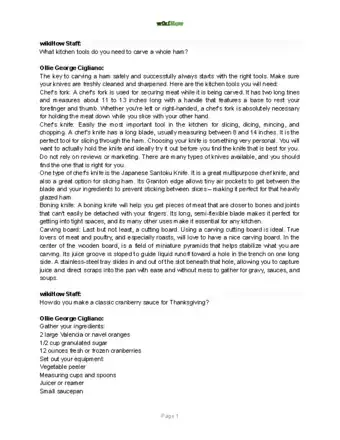
Thanks for reading our article! If you'd like to learn more about carving a ham, check out our in-depth interview with Ollie George Cigliano.
References
- ↑ http://www.realsimple.com/food-recipes/cooking-tips-techniques/preparation/carving-ham/step-2-1
- ↑ http://www.bonappetit.com/test-kitchen/inside-our-kitchen/article/the-leg-bone-s-connected-to-the-shank-bone
- ↑ http://www.recipetips.com/kitchen-tips/t--665/carve-a-ham.asp
- ↑ http://www.recipetips.com/kitchen-tips/t--757/carving-ham.asp
About This Article
To carve a whole ham, place it on a cutting board and stabilize it with a fork. Next, place your carving knife at the shank end and cut thin, vertical slices across the ham, sinking the knife all the way down to the bone for maximum effect. After the slices are cut, make a horizontal cut that is parallel to the bone to release the slices. Turn the ham and continue carving slices this way until there's no meat left on the bone! For tips on carving a spiral cut ham, read on!

